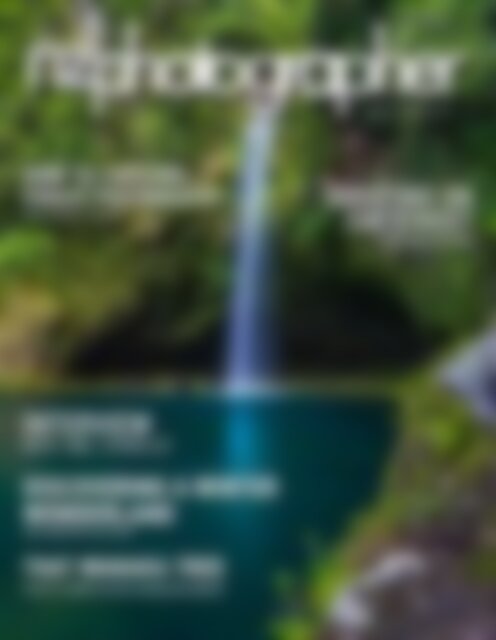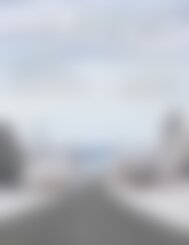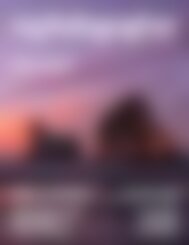NZPhotographer Issue 7, May 2018
As of December 2022, NZPhotographer magazine is only available when you purchase an annual or monthly subscription via the NZP website. Find out more: www.nzphotographer.nz
As of December 2022, NZPhotographer magazine is only available when you purchase an annual or monthly subscription via the NZP website. Find out more: www.nzphotographer.nz
Create successful ePaper yourself
Turn your PDF publications into a flip-book with our unique Google optimized e-Paper software.
ISSUE 7, <strong>May</strong> <strong>2018</strong><br />
HOW TO CAPTURE:<br />
FOREST PHOTOGRAPHY<br />
WITH RICHARD YOUNG<br />
SHOOTING ON<br />
THE STREET<br />
WITH SHANE WHITMORE<br />
INTERVIEW<br />
WITH JOEL STAVELEY<br />
DISCOVERING A WINTER<br />
WONDERLAND<br />
WITH BRENDON GILCHRIST<br />
THAT WANAKA TREE<br />
PHOTO COMPETITION ANNOUNCEMENT<br />
<strong>May</strong> <strong>2018</strong><br />
1
General Info:<br />
<strong>NZPhotographer</strong> <strong>Issue</strong> 7<br />
<strong>May</strong> <strong>2018</strong><br />
Cover Photo<br />
by Joel Staveley<br />
eyesore.co.nz<br />
Publisher:<br />
Excio Group<br />
Website:<br />
www.excio.io/nzphotographer<br />
Group Director:<br />
Ana Lyubich<br />
ana@excio.io<br />
Editor:<br />
Emily Goodwin<br />
Graphic Design:<br />
Maksim Topyrkin<br />
Advertising Enquiries:<br />
Phone 04 889 29 25<br />
or Email hello@excio.io<br />
About <strong>NZPhotographer</strong><br />
Whether you’re an<br />
enthusiastic weekend<br />
snapper or a beginner<br />
who wants to learn more,<br />
NZ Photographer is the<br />
fun e-magazine for all Kiwi<br />
camera owners –<br />
and it’s free!<br />
© <strong>2018</strong> <strong>NZPhotographer</strong><br />
Magazine<br />
All rights reserved.<br />
Reproduction of any<br />
material appearing in this<br />
magazine in any form is<br />
forbidden without prior<br />
consent of the publisher.<br />
Disclaimer:<br />
Opinions of contributing<br />
authors do not necessarily<br />
reflect the opinion of the<br />
magazine.<br />
2 <strong>NZPhotographer</strong><br />
Hello Everyone,<br />
WELCOME TO ISSUE 7 O<br />
I'm very pleased to be taking<br />
over the role of NZP editor. Taya<br />
is in the process of moving to<br />
a new city but we hope she'll<br />
still drop by here and contribute<br />
some articles every once in a<br />
while. We wish her all the best in<br />
her new life and of course in her<br />
photography journey.<br />
You'll notice some changes right<br />
here on the editors welcome<br />
and contents page, what do<br />
you think? We love to get your<br />
feedback so do let us know<br />
what you like/dislike and feel<br />
free to share your thoughts and<br />
ideas on what you would like us to cover in future issues. We're always<br />
looking for people to contribute whether in an interview or a guest post<br />
feature so don't be shy – Drop us a line if you want to share your love of<br />
photography and knowledge with our readers.<br />
Talking of contributing, you'll want to turn to page 39 so you can submit to<br />
our <strong>May</strong> photo competition – We're eagerly awaiting the influx of Wanaka<br />
Tree photos and wish everyone the very best of luck.<br />
CONTRIBUTORS<br />
Ray Harness<br />
Ray is an amateur<br />
photographer who has<br />
dabbled in photography<br />
for 45 years. He has a lot<br />
of pre-digital knowledge<br />
under his belt and enjoys<br />
capturing landscape<br />
scenes and animals.<br />
Richard Young<br />
Richard is an awardwinning<br />
landscape and<br />
wildlife photographer<br />
who teaches<br />
photography workshops<br />
and runs photography<br />
tours. He is the founder<br />
of New Zealand<br />
Photography Workshops.<br />
Emily Goodwin<br />
Editor NZ Photographer<br />
Brendon Gilchrist<br />
Brendon is the<br />
man behind ESB<br />
Photography. He<br />
treks from sea to<br />
mountain, and back<br />
again, capturing the<br />
uniqueness of New<br />
Zealand’s unforgiving<br />
landscape.<br />
nzphotographer nzp_magazine nzp@excio.io
F NZ PHOTOGRAPHER MAGAZINE<br />
4<br />
8<br />
Chasing the Aurora<br />
Interview with Joel Staveley<br />
4<br />
CHASING<br />
8<br />
INTERVIEW<br />
16<br />
26<br />
28<br />
30<br />
32<br />
36<br />
40<br />
41<br />
THE AURORA<br />
by Billy Nunweek<br />
WITH JOEL STAVELEY<br />
SHOOTING ON THE STREET; INSPIRATION & TIPS<br />
HOW TO CAPTURE: FOREST PHOTOGRAPHY<br />
by Richard Young<br />
PROJECT SHUTTER 111<br />
BACK TO BASICS PART 5 - FLASH PHOTOGRAPHY<br />
by Ray Harness<br />
BEHIND THE SHOT WITH GEORGE VAN HOUT<br />
DISCOVERING A WINTER WONDERLAND<br />
by Brendon Gilchrist<br />
EXPERT CRITIQUE<br />
READERS SUBMISSIONS<br />
36<br />
16<br />
Discovering a winter<br />
wonderland<br />
Shooting On The Street
CHASING THE AURORA<br />
with Billy Nunweek<br />
4 <strong>NZPhotographer</strong>
F3.5, 15s, ISO400<br />
<strong>May</strong> <strong>2018</strong><br />
5
The aurora is what I would consider the creme<br />
de la creme of night photography. It has always<br />
been a dream of mine to see the aurora with<br />
my naked eyes and in <strong>May</strong> 2017 that dream<br />
became a reality as I watched the Southern<br />
Lights beam, dance, and light up the sky with their<br />
magical beauty! I’d best describe it as a faint green<br />
snake slithering along the horizon, moving back and<br />
forth. I can’t compare it to anything else because it<br />
was the most beautiful thing I’ve ever seen!<br />
Since that incredible night spent at Birdlings Flat,<br />
Canterbury I’ve been determined to photograph this<br />
fascinating phenomenon and photograph it well. The<br />
following is an account of my quest towards nailing<br />
the aurora.<br />
DAY ONE – 6 SEPTEMBER 2017<br />
The day started off like any when my phone pinged,<br />
my mate Larryn (an Auckland based photographer)<br />
was asking if I’ll be home in Christchurch over the next<br />
few days. He’d been checking various aurora focused<br />
websites which indicated that an aurora was inbound<br />
so after deliberating briefly, discussing the weather<br />
outlook and the likelihood of an aurora in the days to<br />
come, Larryn booked his tickets south.<br />
We had already decided that if this does pan out,<br />
the shot has to be different. It is all well and good<br />
photographing the aurora at a beach looking south<br />
- I’d already done that back in <strong>May</strong>! The goal this<br />
time was to shoot this aurora with a game-changing<br />
composition. We wanted to find a local landscape<br />
that was southward of us that would frame the aurora<br />
nicely. After hunting through photos on the internet<br />
Larryn found an area he was happy with, it was simply<br />
a matter of getting there and into position.<br />
We motored up Dyers Pass Road and followed Summit<br />
Road to a place called Witch Hill Reserve which<br />
would play a big part in our sleepless nights! We set<br />
up just after the sun went below the Southern Alps, the<br />
light was dull, the cloud thick and the wind blowing a<br />
gale. It didn’t make for a comfortable night - Though<br />
the predicted temperature was a low of 8C, the wind<br />
chill made it much cooler.<br />
One of the challenges we came across early on was<br />
the moon, a weak aurora isn’t visible while the sun is<br />
up, or in the moonlight. Its only visible against the dark<br />
night sky and the full moon threatened to turn what<br />
would possibly be a clearly visible aurora with both<br />
eyes and camera into nothing more than a barely<br />
distinguishable disturbance on the horizon. There<br />
was a good chance that because of the moon, high<br />
cloud, and city lights that we wouldn’t see the aurora<br />
at all, but for the shot we had in mind we were willing<br />
to take that risk!<br />
During the night, through patchy reception, we<br />
started getting reports of an X 9.3 Solar Flare, the<br />
biggest since an X 9.4 in 1994. Though nothing could<br />
6 <strong>NZPhotographer</strong><br />
be guaranteed if that flare was to reach Earth the<br />
results could be incredible, a once in a generation<br />
phenomenon. But with no result foreseeable at 4am<br />
we called it a dud and I shot home to get a few hours<br />
sleep.<br />
DAY TWO – 7 SEPTEMBER 2017<br />
After a few hours of disturbed sleep I woke up with<br />
the aim to spend the afternoon scouting a place to<br />
shoot the aurora. We were so determined to shoot<br />
something more than the southern lights over the<br />
ocean but unfortunately, the weather on the West<br />
Coast took a drastic turn for the worst taking a lot of<br />
potential compositions out of contention. For those<br />
who don’t know, Canterbury is located on a large<br />
featureless plain that stretches from the Southern Alps<br />
to the East Coast so finding a unique location is a<br />
challenge in itself!<br />
We eventually settled on a few locations on the<br />
city side of the Lyttelton Harbour. We went to a spot<br />
up in the hills to check it out and then raced back<br />
to town to collect our gear. One of our biggest<br />
concerns was that with all the media hype we would<br />
go to a spot and find it already saturated with other<br />
photographers. Luckily we came across no one, the<br />
cloud and high winds had frightened everyone off<br />
the hills and send them down to Birdlings. We set up<br />
camp, better prepared this time for the wind chill with<br />
blankets, sleeping bags, and protection for our gear.<br />
As soon as we set up for the night we had to duck for<br />
cover, in came the rain so we were quickly saturated,<br />
it didn’t last but it was certainly demoralising, even the<br />
moon failed to rise in any dramatic fashion.<br />
DAY THREE – 8 SEPTEMBER 2017<br />
Today was the day! We started yesterday saying<br />
the exact same thing but were determined that we<br />
wouldn’t be saying that phrase again tomorrow.<br />
Hindsight is a wonderful thing. We were demoralised<br />
but remained determined. After fueling up we<br />
checked the latest numbers on various aurora alert<br />
websites and apps when out of nowhere everything<br />
shot through the roof! KP 8.7, solar wind speeds, wind<br />
density, wind Bz and Bt all spiked to numbers that<br />
were quite literally off the charts!<br />
The X 9.3 solar flare had hit, all in the middle of the<br />
day, there was nothing we could do but pray that it<br />
would hold out till dusk. It didn’t. Though the numbers<br />
remained strong they never stood up to what we<br />
experienced that afternoon which was heartbreaking.<br />
We’d worked so hard, we’d contributed so much<br />
time and effort which of course was all apart of it, the<br />
chase and journey make reaching the destination<br />
that much more satisfying. But this was hard to take,<br />
nonetheless, the numbers remained active so we<br />
didn’t lose hope on catching something!<br />
Once we calmed down we started roaming. With the<br />
weather prediction looking the way it did, shooting
the aurora from our originally planned locations<br />
looked unfathomable which again was another blow<br />
- We’d worked hard and scouted for hours for what<br />
seemed like no reason.<br />
So we headed South, it was the only option. The Alps<br />
were still getting battered by the last grasps of winter<br />
so the West Coast was still no option. Periodically<br />
throughout the night every part of the south island<br />
became enveloped in cloud, it was all about picking<br />
a time and place where the aurora would visibly<br />
peak with minimal cloud cover but we couldn’t<br />
find anything that looked in any way worthwhile. I<br />
decided I needed to get some rest, I’d been driving<br />
and stressing for literally days on end, I needed a<br />
break to recover so I could attack this with all my<br />
might. I left Larryn at Rapaki Jetty, a beautiful little<br />
spot on the Lyttelton Harbour shoreline that was well<br />
guarded against the winds ripping through from<br />
the West Coast. Larryn said he’d call me if anything<br />
happened...<br />
12.23am. My phone rings, I wake up but decline the<br />
call in my slumber. Seconds later, it rings again, I come<br />
around and see it’s Larryn. In the 16 second call that<br />
followed all I can recall is Larryn going nuts saying ‘It’s<br />
beaming, it’s going off, get out here!’. I went from<br />
zero to one hundred, I barely recall getting in the<br />
car. It took me 23 minutes to reach him and when I<br />
arrived the aurora was still beaming incredibly. I didn’t<br />
miss it, Larryn was running around like a madman!<br />
Then it just blew up, the sky lit up, I stood there in awe<br />
of what was unfolding before me, I snapped shots<br />
progressively as it got bigger and bigger and definitely<br />
got lost in the moment. I didn’t capture it as well as I<br />
would have liked, again a learning curve. I was guilty<br />
of losing focus due to the incredible display Mother<br />
Nature was putting on for us, we jumped around, we<br />
danced, we yelled and cheered! I’m adamant we<br />
woke up New Zealand!<br />
Words cannot describe how incredible it is to see<br />
an aurora, photographs do not do it justice. You<br />
simply have to see it. We watched through the night<br />
only leaving when it got to the point where I had to<br />
take Larryn to the airport. He was booked on a 6am<br />
flight but by then it had truly died down. My blood<br />
was pumping, I felt enlightened, it was all so out of<br />
this world. It was a once in a lifetime event that I<br />
fully intend to experience again. I’m aiming for the<br />
Northern Lights now, but until then I will chase every<br />
aurora here in New Zealand while I am still capable.<br />
FINAL THOUGHTS<br />
This story has a happy ending which is never<br />
guaranteed – Those first gruelling unsuccessful<br />
all-nighters that we experienced are a true<br />
representation of the life of a landscape<br />
photographer! Quite often we put in the hard yards<br />
and come up with nothing. It isn’t as easy as hopping<br />
out of your car, pointing your camera and clicking a<br />
button as some people think! We find these incredible<br />
places, we photograph the night sky and that takes<br />
determination and perseverance. This is why we cry,<br />
this is why we dance, this is why we scream, this is why<br />
we laugh. In this case, it all paid off in the end.<br />
<strong>May</strong> <strong>2018</strong><br />
7
INTERVIEW WITH<br />
Joel Staveley<br />
JOEL, CAN YOU TELL US ABOUT YOURSELF?<br />
I live a bit of an unusual life as a digital media<br />
partner, promotional content producer, and<br />
adventure-tour guide.<br />
I grew up on the North Shore of Auckland and spent<br />
most of my life there until I ended up on a farm in<br />
Pukekohe to live close to work at the Glenbrook steel<br />
mill. My background is in engineering and I spent<br />
a number of years as a reverse engineering and<br />
3D visualisation consultant after moving on from a<br />
science role.<br />
In a way, I’ve been fortunate to have no family<br />
commitments which has given me a lot of freedom<br />
to travel around New Zealand and some of the<br />
world. This has resulted in the lines between my<br />
personal life, my work, and my hobbies becoming<br />
increasingly blurred - for better or for worse!<br />
WHAT’S YOUR PHOTOGRAPHY<br />
BACKGROUND? HOW DID IT ALL START?!<br />
I haven’t done any photography courses or been<br />
mentored so I suppose I represent a generation of<br />
self-learners. In fact, it wasn’t until late last year that I<br />
finally had the opportunity to take photos alongside<br />
another person for the first time - more than 4 years<br />
after I started!<br />
I started photography within 2 weeks of landing my<br />
first full-time job after university. Before I received my<br />
first paycheck I felt unusually compelled to purchase<br />
a camera, and so I did. I came home with a second<br />
hand Canon 5D Mk II with a 24-105mm F4L. My family<br />
thought I was crazy. I didn’t know how to use it and I<br />
had never taken any interest in photography before<br />
but I was already quite interested in film-making in<br />
the years that preceded this.<br />
I took thousands upon thousands of awful photos<br />
over my working years and struggled to find time to<br />
take them given the intensity of my work. Throughout<br />
this time I changed camera bodies 3 times and I<br />
traded too many second-hand lenses to count. I<br />
left the industry and went travelling with my camera<br />
although it wasn’t the focus of the trip. The break was<br />
desperately needed and it would forever ignite my<br />
interest in photography - even if I was forced to deal<br />
with a single 14mm lens for the entire trip due to a<br />
lens failure. After I came back from travelling I started<br />
Eyesore Digital and officially began my journey into<br />
intra-disciplinary digital media.<br />
TELL US MORE ABOUT THE COMMERCIAL<br />
PHOTOGRAPHY SIDE OF YOUR BUSINESS.<br />
Most of my photos are used for sales-focused<br />
marketing in the digital space to promote businesses<br />
and organisations, or what they do. I take a different<br />
approach to commercial photography in that I don’t<br />
only offer still photography for my clients. A service<br />
they’ve come to really value is one where I extract<br />
and edit stills from video. While there are still a lot<br />
of technical limitations they find it a revolutionary<br />
approach and the fact that there are thousands<br />
of usable frames to choose from gives them lots of<br />
opportunities to get what they want. I primarily shoot<br />
video on an electronic gimbal which has made this<br />
much easier to pull off.<br />
I’ve always looked for points of difference. One<br />
of the less popular avenues of photography I’ve<br />
explored commercially is 360 VR HDR imaging.<br />
I worked extensively with VR in engineering. This<br />
was simply a step into other verticals using similar<br />
techniques and a different approach.<br />
Something else I’ve done a lot of is adventuretourism<br />
photography in recent years. As a<br />
8 <strong>NZPhotographer</strong>
driver-guide, I have the opportunity to travel with<br />
groups of international students and share the New<br />
Zealand experience with them. My photos are used<br />
to market NZ tourism and education both here and<br />
overseas, and the students take my photos back to<br />
all corners of the globe.<br />
YOUR CITY NIGHT SHOTS ARE SUPERB. WHAT<br />
ADVICE CAN YOU GIVE OUR READERS FOR<br />
CAPTURING SHOTS LIKE THIS?<br />
Lens flares and light leaks are difficult to avoid when<br />
there’s so much uncontrolled light in a dark city<br />
scene so using a lens hood and removing filters might<br />
be necessary. I’ve found that polarising filters can<br />
sometimes have a dramatic effect on city scenes<br />
because concrete and buildings can be quite<br />
reflective. Always try to experiment, even if you have<br />
to look silly standing behind a camera at a street<br />
corner for 5 or 10 minutes of exposures. Sometimes it<br />
becomes necessary to composite out lens flares from<br />
lights that can’t be avoided - Blocking out the flare<br />
source throughout the exposure using a dark object<br />
can be a life-saving technique.<br />
WHAT EQUIPMENT DO YOU HAVE?<br />
I currently use the Sony A7R II for the bulk of my work<br />
which has been a great hybrid camera even with its<br />
faults. I have a variety of lenses including the Sony<br />
12-24mm F4 G, 24-70mm F2.8 GM, 70-200mm F2.8<br />
GM, 85mm F1.4 GM, 90mm F2.8 Macro, 55mm F1.8<br />
Zeiss, 16-35mm F4, Sigma 35mm F1.4 Art and a Sigma<br />
15mm F2.8 diagonal fisheye for VR photography. I<br />
recently picked up a 150mm filter system for the 12-<br />
24mm which is looking like a great combination and<br />
offers something a bit more unique than what a 16-<br />
35mm can offer.<br />
I use a few Godox strobes and modifiers with the<br />
SMDV Speedbox 70 being my portable go-to used<br />
with HSS triggers. I have a wide range of video<br />
and sound gear to support using the system for<br />
cinematography including a MoVI M5 gimbal plus<br />
additional rigs and lights.<br />
ANY BIG NAME BRANDS YOU’VE WORKED<br />
WITH?<br />
I’ve been working with Panasonic lately and a few<br />
other brands in the technology and security sector.<br />
Over the last few years I have worked on media<br />
projects for General Electric, Bluescope, Spotless,<br />
Woodside and a few others in the industrial space.<br />
WHAT’S THE BEST PART ABOUT YOUR JOB…<br />
AND THE WORST PART?!<br />
The best part is getting to do what I’m passionate<br />
about each day and being able to travel. The mix of<br />
guiding and media is like jumping from one extreme<br />
to another but it’s rewarding to capture and share<br />
people’s experience as they travel through our<br />
country.<br />
The worst part is trying to manage the inconsistent<br />
workload and sacrificing a personal life far more<br />
often than I’d like.<br />
<strong>May</strong> <strong>2018</strong><br />
9
10 <strong>NZPhotographer</strong>
<strong>May</strong> <strong>2018</strong><br />
11
12 <strong>NZPhotographer</strong>
<strong>May</strong> <strong>2018</strong><br />
13
WHAT ADVICE WOULD YOU GIVE OUR<br />
READERS ON TURNING PHOTOGRAPHY INTO<br />
A CAREER?<br />
I believe that skill diversification and the need to<br />
embrace new technology will become even more<br />
important in the near future. I use video to open<br />
doors because there are a lot of businesses and<br />
brands that want or need it, and once the doors<br />
are open the opportunity to perform commercial<br />
photography and other media presents itself as a<br />
media partnership forms.<br />
Working hard, gaining experience, exploring<br />
exposure avenues and always being open to<br />
building new connections are fundamental parts of<br />
turning photography into a career. Collaborating<br />
with people through social media platforms can<br />
be a great way to get your work out there now<br />
and directly engaging with people still remains<br />
the best way to actively secure work in an early<br />
career. When you do this long enough eventually<br />
the tables turn and clients will start engaging with<br />
you first.<br />
HOW DO YOU BALANCE SHOOTING FOR<br />
WORK AND PLEASURE AND HOW DO YOU<br />
STAY INSPIRED?<br />
I face the struggle of balancing work and pleasure<br />
in photography every day, mostly because of how<br />
consuming the variety of work I do can be. There<br />
are times where I put it all down though and more<br />
often than not photography isn’t a focus or priority<br />
during my personal ventures unless I’m out with other<br />
photographers.<br />
I’m an addictive serial learner and I enjoy trying<br />
many different styles of photography from macro to<br />
astro, and portraiture to wildlife which always gives<br />
me something new to do. The fact that there are<br />
no boundaries or limits to learning and creativity in<br />
photography means there’s always room to grow<br />
and I find that liberating and challenging after<br />
coming from the, largely constraint driven, world of<br />
engineering. The endless opportunity to grow drives<br />
me to shoot and experience more and try to make up<br />
for the time I lost in my early years.<br />
14 <strong>NZPhotographer</strong>
WHAT’S THE PHOTO THAT YOU’RE MOST PROUD OF?<br />
It would probably be a simple photo I took of the<br />
pinnacles on Ruapehu. The clouds were rolling in and<br />
the atmosphere was changing every second before<br />
I just managed to capture it. The depth, light, and<br />
atmosphere of the moment created a striking photo of<br />
the daunting rock pillars which are hard to appreciate<br />
when viewing it on a small scale.<br />
WHAT ADVICE WOULD YOU GIVE PHOTOGRAPHERS<br />
WHO WANT TO START TAKING VIDEO?<br />
Most modern DSLR’s and mirrorless cameras can take<br />
great video now which makes it an easy thing to step<br />
into for most photographers. The first two challenges to<br />
overcome when transitioning from photo to video are<br />
stabilisation and exposure control in the form of external<br />
ND filters and the use of a tripod, handheld or shoulder<br />
rigs and mechanical or electronic stabilisers depending<br />
on the filming environment and requirements.<br />
Quality sound is something that’s often overlooked in<br />
transitioning to video and many cameras have poor<br />
analogue inputs which aren’t suitable for sensitive<br />
microphones. The purchase of an isolating or directional<br />
microphone used with an external sound recorder is a<br />
great investment to make and can last you many years<br />
to come since this technology changes at a much<br />
slower pace.<br />
ANY OTHER WORDS OF WISDOM?<br />
While photography courses, workshops, and mentors are<br />
great you should never feel like you can’t learn without<br />
them. No matter what your situation or learning style is<br />
there’s an endless supply of great resources online to<br />
support us.<br />
Photography skills can take a long time to develop (I<br />
speak from experience!) but if you’re patient and persist<br />
it becomes second nature and the camera will become<br />
like your third eye. Explore every worthwhile avenue and<br />
channel you can to build connections and be seen.<br />
Sometimes it can take years for opportunities to manifest<br />
but it only takes one to turn your world upside down.<br />
WHERE CAN WE FIND YOU ONLINE?<br />
www.joel.eyesore.co.nz<br />
www.eyesore.co.nz<br />
www.linkedin.com/in/nzsjoel<br />
www.instagram.com/nzsjoel<br />
<strong>May</strong> <strong>2018</strong><br />
15
Shooting On The Street<br />
Inspiration & Tips with Shane Whitmore<br />
about shooting, post-processing or how to conduct<br />
model shoots. I now shoot with a Sony A7rii with 24-70<br />
f2.8 g-master or 70-200 f2.8 g-master.<br />
I like shooting streetscapes and incorporating models<br />
into this style, I think it’s unique and allows for freedom<br />
to break all of the photography rules. I edit each<br />
picture individually and just see where it takes me, I<br />
don’t stick to any formula (I don’t think)!<br />
My typical portrait sessions last 2-3 hours. This gives<br />
myself and the model time to adjust to each others<br />
style and allows us both to relax into a natural working<br />
environment, which will always make for better, more<br />
natural art. I don’t tend to plan a shoot location<br />
ahead of time, I prefer to walk around the city finding<br />
interesting walls, alleyways, different textures and<br />
chasing the light. I generally have no idea of what I<br />
want to achieve that day or how the shoot will turn out.<br />
Its more off the cuff and if it happens, it happens!<br />
Most of my photo shoots are from people liking my<br />
work on Instagram. My website has also attracted<br />
work, bringing me both corporate events and<br />
modelling portrait shoots. See more of my work and<br />
follow me by visiting:<br />
Shane Whitmore, better known as Mr Wiski, is<br />
a street, fashion, and portrait photographer who<br />
scouts out unique locations in Auckland to give his<br />
photography an edge.<br />
I was inspired to get into photography when a<br />
wedding photographer ‘friend of mine’ Ralph<br />
Cabman, took some nightclub photos of myself and<br />
some friends. I was amazed at the quality and the<br />
vibrant colours. Soon after I went out and purchased<br />
my first DSLR, a Canon 70D and a 24-70 lens. That was<br />
back in 2016. Since then I have lived on Youtube,<br />
absorbing as much information I can whether it be<br />
MY TOP TIPS ARE:<br />
• Study the light<br />
• Don’t be scared to break the Photography Rules -<br />
Try new ideas, be unique.<br />
• Take your time to look for leading lines,<br />
shadows, reflections, textures – Be aware of your<br />
surroundings.<br />
• Experiment with the editing process – Have some<br />
fun.<br />
• If you are not 100% happy with a photo, then don’t<br />
post it. Keep your standards high!<br />
• Never stop learning - Read books and watch<br />
YouTube tutorials.<br />
www.mrwiski.com<br />
www.instagram.com/mr_wiski<br />
16 <strong>NZPhotographer</strong>
F5.6, 1/125s, ISO800<br />
Model: Natalie Connell<br />
CATWOMAN:<br />
This shot was taken from a high-rise rooftop in<br />
Auckland. The Catwoman look wasn’t planned,<br />
it just so happened that a mask we had worked<br />
well with the models outfit! The relaxed pose really<br />
worked well for this shot. I added personal touches<br />
in Photoshop like the graffiti and the dragon hand<br />
tattoo. What I really like about the finished product<br />
is the natural laidback pose and the metallic<br />
look the clothing gives. It’s also a plus that such<br />
an iconic building, the Auckland sky tower was<br />
captured!<br />
<strong>May</strong> <strong>2018</strong><br />
17
F4, 1/50s, ISO1200<br />
Model: Kodie Whitmore<br />
MIRRORED ALLEYWAY:<br />
The model in this shot is my daughter Kodie, she<br />
also likes to roam the streets shooting... Like Father,<br />
like Daughter! I came across this mirrored platform<br />
with amazing side lights and leading lines running<br />
down the shot in Auckland CBD. I wanted a pose<br />
that would suit both the scene and look good in<br />
the mirrored reflection. With locations like this, not<br />
a lot of thinking needs to be done. I added the<br />
graffiti in Photoshop. This shot reminds me of a film I<br />
loved when growing up; Big Trouble In Little China,<br />
It definitely has that film feeling...<br />
18 <strong>NZPhotographer</strong>
F11, 1/250s, ISO100<br />
BUILDINGS:<br />
I liked the sharpness of this corner building in<br />
Auckland, amazing angles to work with. Throw in<br />
the texture of the background high rise building<br />
(Auckland’s first skyscraper so I’m told) and you<br />
have a fantastic streetscape shot. I added in the<br />
sky, the graffiti, and the sun glow afterward. I’m<br />
most impressed with the clarity of the building in<br />
conjunction with the soft sky and soft light in this<br />
shot.<br />
<strong>May</strong> <strong>2018</strong><br />
19
F1.4, 1/125s, ISO100<br />
CHINESE PORTRAIT:<br />
This shot was a single 1/125 of a second click but a 7 hour<br />
editing process! This lovely lady was selling bracelets on the<br />
street in New Market, Auckland. I asked if I could take her<br />
picture and she kindly obliged. This 7 hour edit was a lot of<br />
trial and error with different gradients and flares added. I love<br />
her mystique look which complements the light, making for a<br />
fantastic portrait.<br />
20 <strong>NZPhotographer</strong>
F2.8, 1/15s, ISO800<br />
RED DRESS:<br />
Model: Jahna Barraclough<br />
MUA: Natalie <strong>May</strong> Cerche<br />
This was a wonderful learning curve as every rule about taking a portrait went out the door! A still camera<br />
was swapped with a moving camera. To get this portrait it would require movement and since the model<br />
was stationary I needed to create that movement with my camera, whilst freezing the models face. I set the<br />
camera to a slow shutter speed to create motion when panned. I had an on-camera flash set to rear curtain,<br />
this allowed the flash to fire only after the shutter had closed to create the blur whilst freezing the subject. Once<br />
focused on the model, the camera was then moved to her left, the camera pan moving left to right. Multiple<br />
camera pans were taken to get usable shots, the timing of when to push on the shutter being very much trial<br />
and error for me! I ended up taking about 30 shots, ending up with about 5 that I was happy with.<br />
<strong>May</strong> <strong>2018</strong><br />
21
F1.8, 1/125s, ISO100<br />
CANON:<br />
Nothing was pre-planned for this shot, the magic just<br />
happened! It’s my daughter holding the camera<br />
and combined with the way she was holding it, and<br />
it being called a canon, I was inspired to have some<br />
fun and channel the ‘act of war’ theme in postprocessing!<br />
Some smoke and some added particle<br />
overlays seemed to make the photo pop. I love the<br />
bokeh that this shot offers, I think the green t-shirt<br />
really compliments the style of photo as does the<br />
positioning of her hands.<br />
22 <strong>NZPhotographer</strong>
F8, 1/15s, ISO100<br />
TRAIN:<br />
Here's a breakdown of how I created this shot.<br />
With my camera on a tripod 2 shots were taken. The first,<br />
a long exposure of the train using a 10 stop ND filter. The<br />
second, now without the filter and without the train, was<br />
of the tracks and myself. I could then blend both shots in<br />
Photoshop and paint myself in!<br />
I blended the 'Look For Trains' sign on to the back of my<br />
tshirt and also added in the sun flare with Photoshop. I used<br />
Gaussan Blur to soften the light and make it more natural<br />
looking and then altered the colours in Lightroom.<br />
<strong>May</strong> <strong>2018</strong><br />
23
F2.8, 1/400s, ISO100<br />
24 <strong>NZPhotographer</strong><br />
MASTER CARVER:<br />
Strong working hands caught my eye for this shot taken in<br />
Claris, Great Barrier Island. I feel hands can tell as much a<br />
story as eyes or a face. I also liked the texture of the wood<br />
carving. I added my personal touches to this already<br />
awesome shot... A touch of graffiti, a splash of light to the<br />
mallet and some colour/contrast play to the picture. What I<br />
really like about this shot is the depth of field mixed with the<br />
beautiful bokeh.
Photographer: Richard Young<br />
FH100M2 Long Exposure Kit<br />
The FH100M2 Filter: It is designed to hold both square and circular filters, with the ability to freely<br />
rotate an attached 82mm CPL filter after installation.<br />
It will hold up to 3 square filters, and ultra-thin 82mm CPL simultaneously, without creating<br />
vignetting on lenses as wide as 16mm.<br />
Includes: FH100M2 holder (incl FR1010, FR1015, 77mm and 82mm adapters)<br />
FB100M2 case<br />
0.6 Hard Grad<br />
6-stop ND<br />
10-stop ND<br />
CPL Filter<br />
FR1010 Frame<br />
82-72mm Stepdown ring<br />
82-67mm Stepdown ring<br />
Progear<br />
www.progear.co.nz<br />
3 Railway St, Newmarket<br />
09 529 5055<br />
<strong>May</strong> <strong>2018</strong><br />
25
HOW TO CAPTURE: FOREST PHOTOGRAPHY<br />
Forest Photography Tips with Richard Young<br />
Forest, Tongariro National Park<br />
F11, 1/2s, ISO400, 35mm<br />
GET THE LEAVES IN FOCUS<br />
If you are singling out a subject in your shot, like a<br />
particularly stunning tree, make sure that this is in<br />
focus along with any ferns or plants on the ground.<br />
If you are photographing in low light on an overcast<br />
day you will need to use a tripod or select a higher<br />
ISO to get a shutter speed which is fast enough for a<br />
sharp image.<br />
CAPTURE THE FOREST FLOOR:<br />
Often the forest floor is covered in lush ferns and other<br />
beautiful small plants; include these in your shot.<br />
Sometimes these on their own can make the best<br />
shot. Getting down low to photograph them works<br />
best.<br />
SHOOT ON AN OVERCAST DAY<br />
Taking photos in the forest on a bright day is hard,<br />
the hash light creates a great deal of contrast and<br />
makes exposure more difficult. If possible head out on<br />
an overcast day. Unusual lighting and weather can<br />
make a more unique photograph of the forest. Sun<br />
can occasionally add to an image if you can capture<br />
rays of light breaking through the trees.<br />
FIND A SUBJECT:<br />
It is often hard to know where to point your camera<br />
and you have to be careful not to end up with a<br />
cluttered shot of lots of trees. Single out a subject for<br />
your shot. This could be a particularly stunning tree,<br />
a splash of a contrasting colour, or a pattern on the<br />
bark.<br />
IMPROVE YOUR FOREST PHOTOGRAPHY ON A WEEKEND TONGARIRO WORKSHOP: 17TH-19TH<br />
AUGUST <strong>2018</strong> WITH NEW ZEALAND PHOTOGRAPHY WORKSHOPS<br />
26 <strong>NZPhotographer</strong>
JOIN AN AWESOME<br />
PHOTOGRAPHY COMMUNITY<br />
NZ $25/year only<br />
Your own portfolio on Excio<br />
30 photos, 100,000+ impressions<br />
100+ clicks to your website/month<br />
Add your Facebook & Instagram profiles<br />
Member-only offers<br />
Discounts from our partners<br />
Free Lightroom presets<br />
“Early bird” access to events and meetups<br />
Competitions<br />
Get free entry into all competitions and earn<br />
by participating in photo challenges<br />
BECOME A MEMBER<br />
www.excio.io/membership<br />
<strong>May</strong> <strong>2018</strong><br />
27
PROJECT SHUTTER111<br />
1 CAMERA – 1 YEAR – 1 COUNTRY<br />
Brett Jennings of Red Bird Photography is running<br />
a project that will see one camera pass from one<br />
photographer to another over the span of a year<br />
to capture what it means to live in New Zealand.<br />
Keen to promote the amazing photography<br />
talent that New Zealand has, this project is about<br />
appreciating film photography and collaborating on<br />
a county-wide photography project using one shared<br />
film camera.<br />
Brett is seeking 18-24 photographers to take part in this<br />
project. The brief is fairly open, each photographer<br />
should bring their own unique perspective and style<br />
into the project with the choice of colour of B&W<br />
film to capture what it means to them to live in New<br />
Zealand. The project will be as geographically diverse<br />
as possible, covering the majority of the country over<br />
the year with the camera (yet to be determined)<br />
used over a two-week period, then sent on to the next<br />
photographer.<br />
All photographs submitted will be shared on the<br />
shutter111.com website along with a description<br />
of the images and a bio of each photographer,<br />
there’s also the possibility of an exhibition of the<br />
best photographs taking place once the project is<br />
completed.<br />
If you’re interested in taking part, contact Brett at<br />
brett@redbird.photos and let him know where you live<br />
and where you’ll be over the next year so that he can<br />
plan the logistics of moving the camera from person<br />
to person.<br />
We’ll be documenting the project here at NZ<br />
Photographer in future issues, sharing photos as the<br />
camera makes its journey around the country.<br />
28 <strong>NZPhotographer</strong>
<strong>May</strong> <strong>2018</strong><br />
29
BACK TO BASICS PART 5<br />
FLASH PHOTOGRAPHY<br />
Today’s DSLR cameras have built in flash and<br />
TTL (Through the Lens) exposure but when I first<br />
started in photography things were very different.<br />
With manual SLRs, we used flash bulbs and had<br />
to consider distance and aperture as TTL flash didn’t<br />
exist until the 1970’s!<br />
The camera had a flash sync speed on the shutter<br />
speed dial for use with electronic flashguns, these<br />
varied according to the camera but were typically<br />
1/60th or 1/80th of a second. If the flash sync speed<br />
on the shutter dial was not set, the flash would fire<br />
at what shutter speed was set, resulting in too fast a<br />
speed being used giving you half a picture because<br />
the shutter was already closing when the flash fired.<br />
Thankfully these problems don’t exist today! With<br />
TTL, the exposure is read from the light entering the<br />
camera lens with the CCD sensor closing the flash at<br />
the correct moment to ensure accurate exposure.<br />
30 <strong>NZPhotographer</strong><br />
All flash units today have a guide number, (you<br />
will find this in the flash section of your manual),<br />
this dictates the strength of the flash over a given<br />
distance. On my camera, the built in flash has a guide<br />
number of 15 metres at ISO 200. That is to say that<br />
the flash will be effective at that distance. Anything<br />
beyond that will suffer from light fall off and dark<br />
exposure.<br />
ON-CAMERA FLASH SETTINGS<br />
With most cameras, the settings for the flash are as<br />
follows, the first two being the most popular:<br />
Auto Front Curtain: This fires the flash at the moment<br />
of shutter release, capturing the subject immediately.<br />
This is very useful when taking pictures at functions,<br />
where you are not posing the subjects, and are<br />
looking to capture spontaneous shots. Journalist<br />
photographers use this as the only thing of interest is<br />
their immediate subject, so the pictures can be taken<br />
off the cuff with the subject on the move.
Auto Rear Curtain: This fires the flash at the end of the<br />
shutter release, exposing background elements in<br />
the picture before the flash fires on the main subject.<br />
This is best used when you want to show some of the<br />
background surrounding the subject. An example<br />
would be someone giving a speech with people and/<br />
or signs behind them.<br />
Rear Curtain with Slow Sync: With this setting the<br />
camera meters the scene and then sets the shutter<br />
speed to correctly expose all of the background<br />
before firing the flash at the end to correctly expose<br />
the main subject. You would typically use this in<br />
night portraiture or architectural night scenes. To<br />
successfully use this setting you need to use a tripod,<br />
preferably with a remote release, and make sure that<br />
the subject remains still for the length of the exposure.<br />
Fill in Flash: This is where the camera will use a<br />
small amount of flash to correct shadowed areas<br />
in a picture in situations where the subject has light<br />
coming from behind or to the side, as opposed to the<br />
front. It’s particularly useful when taking portraits and<br />
group pictures outside to balance the shadows and is<br />
commonly used at weddings. To use this setting, pop<br />
the flash manually (usually by pressing a button on the<br />
side of your camera) and the camera will apply the<br />
correct amount of fill in flash, depending how much<br />
of your subject is shaded. You can also use this to<br />
freeze frame movement so that the scene is correctly<br />
exposed but the movement not seen.<br />
Red Eye Reduction: This setting is found in the flash<br />
menu on your camera, and as the name suggests,<br />
it limits the amount of flash light reflected from the<br />
retinas in our eyes. In animals instead of showing as<br />
red light, it can be green or yellow. In this instance,<br />
the camera sends a burst of pre-flash to constrict the<br />
pupils thus restricting the amount of light entering the<br />
eyes.<br />
FLASH COMPENSATION<br />
If you discover your flash photography looks washed<br />
out or too dark, adding compensation should correct<br />
the problem. In the flash menu, after setting what kind<br />
of flash you wish to use, find the compensation + and<br />
– setting and adjust accordingly. The compensation<br />
settings are usually made in increments of either<br />
1/3rd or 1/2 half stops to allow finer control of the<br />
output. The minus will reduce output and the plus<br />
increase it. If, for example, you photograph a floral<br />
display indoors and the blooms appear washed out,<br />
set compensation on the minus side to correct the<br />
exposure. If on the other hand, the metering has<br />
caused the blooms to appear dull and understated,<br />
set the flash compensation on the plus side to<br />
obtain a more even look. Remember to turn off<br />
compensation when you are finished, not all cameras<br />
automatically do this meaning subsequent shots will<br />
be over or underexposed!<br />
OFF CAMERA FLASH UNITS<br />
Whilst the on-camera pop-up flash is fine for most<br />
amateur photographers, there may be a time when<br />
you require something more powerful, particularly<br />
if you’re passionate about portrait photography.<br />
Off camera flash units are more versatile, are more<br />
powerful therefore giving greater range and give you<br />
better control over shadowing and reducing red eye<br />
effects, but they’re not cheap!<br />
There are many off camera units available, whether<br />
third party units or ones made and designed for your<br />
camera by your camera manufacturer. These units<br />
are fitted with a module dedicated to your camera’s<br />
electronics which allow your camera’s metering<br />
system to control the flash correctly. The dedicated<br />
modules respond via the wireless function (if your<br />
camera has this) allowing you to add one or more for<br />
studio work.<br />
You can use these units atop the camera in the<br />
flash “Hot Shoe” on the top of the camera where<br />
the popup flash is situated, or the units will attach to<br />
a flash bracket which you fix to your camera, (this<br />
screws in to the tripod socket on the base, but is<br />
itself threaded to allow the use of a tripod as well)<br />
and means that when photographing people and<br />
animals, the flash is off centre to the eyes, reducing<br />
red eye.<br />
Depending on the type of unit you purchase, it may<br />
have a swivel/bounce head. The swivel allows the unit<br />
to be sited at an angle which is useful for architecture<br />
shots while the bounce throws the light off a ceiling or<br />
a wall which produces a softer look, ideal for avoiding<br />
shadows in portraiture photography.<br />
This overview of flash photography brings us to the<br />
end of the ‘Back to Basics’ series. If you have been<br />
following along from the beginning of these articles,<br />
I hope you are now feeling more comfortable with<br />
understanding what all the buttons and different<br />
settings do on your camera and how to use them<br />
to help you take the next step in your photography<br />
journey.<br />
***<br />
By Ray Harness<br />
<strong>May</strong> <strong>2018</strong><br />
31
BEHIND THE SHOT<br />
WITH GEORGE VAN HOUT<br />
32 <strong>NZPhotographer</strong>
F22, 5s to 1/400s, ISO100, 11mm<br />
<strong>May</strong> <strong>2018</strong><br />
33
34 <strong>NZPhotographer</strong><br />
F3.5,1/250s, ISO100, 18mm
GEORGE, TELL US A LITTLE ABOUT<br />
YOURSELF...<br />
I was born and raised in New Zealand. I studied<br />
Engineering at Canterbury and currently work<br />
as an Acoustic Engineer in Christchurch. I met<br />
my fiancé when we were at High School and we<br />
have stayed together ever since. We live with our<br />
beautiful kitten (Artoo) and two horses (Choccy<br />
and Roxy).<br />
I grew up around cameras. My father always had<br />
a passion for photography, taking photos of us kids<br />
all the time. In his spare time he used to also do<br />
wedding photography. When we were old enough<br />
he finally let us muck about with his cameras.<br />
About 5 years ago I really got into photography,<br />
finally getting my own semi-professional camera.<br />
Since then I haven’t really stopped taking photos.<br />
I love capturing photos which evoke emotions in<br />
people or help bring back memories.<br />
TELL US ABOUT THIS PHOTO...<br />
We live very close to the Ashley River, and I had<br />
been meaning to head down to the river at sunset<br />
for a while. The evening wasn’t planned, it just<br />
happened that this evening was less busy than<br />
usual. I went down for more of a scoping visit to<br />
take some photos from different angles and to<br />
see how the light fell down the river bed. I was<br />
planning on going back a couple of weeks later<br />
when the sun set down the river more evenly than<br />
off to the side.<br />
With my mini tripod, I set my camera up in the<br />
water very carefully, arranging rocks, sand, and<br />
sticks to ensure that the flowing water wouldn’t<br />
push it over (cameras and water don’t particularly<br />
go well together). I was taking a few long<br />
exposures, so when I stepped back from one I<br />
quickly took a photo with my other camera just so I<br />
knew the angle and orientation for later.<br />
I usually have both of my cameras with me, this<br />
allows me to set them up with different lenses so I<br />
don’t have to worry about changing lenses, missing<br />
shots because of changing lenses, or getting dirt<br />
in the camera and/or sensor. Also in this instance,<br />
because I was scoping the site I wanted to shoot<br />
with one camera and then record the angles, and<br />
setup of the main camera with the other camera<br />
so that if I particularly liked a shot and wanted to<br />
recreate it down the line I had a record of how it<br />
was before.<br />
WHAT EQUIPMENT ARE YOU USING?<br />
The camera that I took the main shot with, the one<br />
shown in the picture above, is the Canon EOS M (the<br />
original), with a Canon EF-M 11-22mm lens, and a<br />
standard CPL filter (which wouldn’t have made any<br />
difference facing the sun). That camera was mounted<br />
on a Pedco Ultrapod. I took the photo of the setup<br />
with my Canon EOS M3 with a Canon EF-M 18-55 mm<br />
lens.<br />
WHAT’S HAPPENING BEHIND THE CAMERA<br />
THAT WE CAN’T SEE?<br />
I’m praying that the camera doesn’t decide it wants<br />
to be a submarine! There is also a little offshoot arm of<br />
the river which comes behind me so I was trying not to<br />
get wet feet either. No one else was around, so it was<br />
very peaceful! After taking a few photos like this, I just<br />
stood and admired the beautiful colours of the sunset.<br />
HOW MUCH POST-PROCESSING DID YOU DO?<br />
I shoot almost all my photos in RAW, but nothing too<br />
major was done to the image. I did some small tweaks<br />
in Adobe Lightroom, mainly with the contract and<br />
brightness to lift the blacks (rocks and camera) up so<br />
they weren’t completely black and toned down the<br />
intensity of the sunset. I upped the vibrancy by about<br />
20% then toned down the saturation by 5%.<br />
The main photo (previous page) is an HDR made<br />
up of 5 photos shot at varying shutter speeds from 5<br />
seconds to 1/400 seconds. The 5 photos were meshed<br />
together in Adobe Lightroom with contrast, brightness,<br />
saturation, vibrancy, clarity, and HSL modifications<br />
made.<br />
IF YOU COULD RE-SHOOT THIS WHAT WOULD<br />
YOU DO DIFFERENTLY?<br />
For the main camera, I would have loved to put an<br />
ND filter on to get a longer shutter speed to really blur<br />
the river more. A bigger sturdier tripod would have<br />
made me a lot less nervous too! As for the photo of<br />
the camera, I probably would have taken more time<br />
in actually setting up the shot. It was more of a point<br />
and shoot job than anything else!<br />
ANYTHING ELSE YOU’D LIKE TO SHARE?<br />
I am ‘borrowing’ my dads original Canon EOS 5,<br />
35mm film camera at the moment which is amazing<br />
fun. Having to think about each shot (rather than<br />
knowing then and there what the photo is like and<br />
adjusting the settings accordingly) has helped me<br />
become a better photographer.<br />
www.pinterest.nz/georgevanhout<br />
www.instagram.com/landdownunder_nz<br />
<strong>May</strong> <strong>2018</strong><br />
35
DISCOVERING A WINTER<br />
WONDERLAND<br />
by Brendon Gilchrist<br />
Cold nights, no lights, shivering in your<br />
boots? Photography shouldn't stop<br />
even in the coldest of winter days. It<br />
provides opportunities that should be<br />
embraced into a new creative vision to capture<br />
unique vistas that the other 3 seasons do not offer<br />
and when winter photography is combined with<br />
mountaineering it's a whole new ball game!<br />
Mountaineering is an activity that few people<br />
experience or even understand, but for those<br />
who do, including myself and my good mate<br />
Justin, they are rewarded with some of the most<br />
spectacular views in some of the most challenging<br />
of conditions.<br />
On this excursion myself and Justin travelled from<br />
Christchurch to Arthur's pass so that we could<br />
climb a peak before heading back to Christchurch<br />
again, all in the same day. You'll be asking are you<br />
mad? The answer is yes, a little! But why not?! You<br />
only have one life with few opportunities to push<br />
36 <strong>NZPhotographer</strong>
F16,1/160s, ISO125<br />
your own limits and have the ultimate reward. As<br />
we leave the house at midnight the night is clear,<br />
the city is still alive but we soon find our way to<br />
open fields driving towards the cold and beautiful<br />
mountains. By 3am we have arrived in Arthurs Pass<br />
Village where our climb begins. We wait a few<br />
moments to try and wake up for what is about to<br />
happen... It's not easy but we get out of the car<br />
and get ready for our climb up Mount Bealey.<br />
Boots on, hat on, head torch at the ready, lock the<br />
car, we are good to go!<br />
It doesn’t take long for us to become too hot in<br />
what we are wearing as the track is steep with a<br />
bit of climbing involved but we'll be grateful for the<br />
layers later. We stop to take a few breathers but<br />
our goal is to be out of the bush and in the snow by<br />
sunrise - A decent 3 hour walk and climb through<br />
the bush in the dark is ahead of us.<br />
Emerging from the bush is always special, to get up<br />
and out onto the tops, to see the glow of morning<br />
slowly coming through and to think about what<br />
you will see and capture. The sunrise this morning<br />
was spectacular with a pink band of cloud over<br />
Mount Rolleston, layers of clouds in the valleys – A<br />
sight that I will never forget.<br />
This climb is my first time climbing something steep<br />
with no ropes (not that I climb with ropes) and<br />
there are a few sections where I feel out of my<br />
comfort zone. This is the day I learnt to trust my<br />
gear... I didn’t have my crampons on but I felt<br />
confident in my boots and ice axe placements. As<br />
we kept ascending, admiring the view along the<br />
way, the climb became a little easier towards the<br />
top.<br />
<strong>May</strong> <strong>2018</strong><br />
37
F2.8,1/60s, ISO125<br />
Photographing while climbing mountains is hard<br />
as you have no set location, no particular place<br />
that you know is there if an opportunity for a photo<br />
happens it happens and if there something good<br />
to put in the foreground that is great. I’m always<br />
last up because my camera gear is heavy, but<br />
its worth it, I need it to be able to record these<br />
moments and tell these stories.<br />
When I reach the top I walk along the summit to<br />
the big cairns, take off my pack off admire the<br />
view. We spent 30 minutes on the summit after a<br />
good solid 4 to 5 hours climbing. Now there's just<br />
time for a quick bite to eat of almost frozen bread<br />
(but at this point any food is good food) before we<br />
make the 4 hour descent.<br />
Going down I see new compositions that I did not<br />
see on the way up. Everything looks different going<br />
this way now that it's light and I see many missed<br />
opportunities that are really photogenic. I will have<br />
to go back to capture some epic selfies!<br />
Once back at the car we celebrate, we did it!<br />
We are happy, tired and sore, but one thing is<br />
for certain, we must get to the Sheffield Pie Shop<br />
before it shuts! It's become almost a tradition with<br />
us; climb during the early hours, get back down<br />
and out, and then rush to the pie shop before it<br />
shuts!<br />
I hope my story has inspired you. Winter is not a<br />
time to hide from the cold. I urge you to dress up<br />
warm and go and discover something new. Be<br />
prepared to get cold but also be prepared to be<br />
rewarded, preferably with a companion so you<br />
can keep safe together. The epic snow days are<br />
near and are waiting for you to capture new and<br />
exciting images to show the world how stunning<br />
this planet is, particularly our corner of New<br />
Zealand.<br />
38 <strong>NZPhotographer</strong>
Wow us with your shots of the Wanaka Tree!<br />
The Wanaka Tree is arguably the most popular tree in New Zealand – almost everyone has at least one shot of<br />
it. We can't begin to tell you how many times we come across a photo of this tree in readers submissions so<br />
we decided to use it as a competition theme! We're excited to see how each image of the same subject shows<br />
off each photographers style and creativity.<br />
Show us what you have and be in to win a 64GB memory card for your camera!<br />
Competition runs 1 -20 <strong>May</strong> <strong>2018</strong><br />
See full T&Cs and submit your best photo using the link: www.excio.io/wanaka<br />
(Please note: for general readers' submissions please use www.excio.io/nzpsubmit)<br />
<strong>May</strong> <strong>2018</strong><br />
39
EXPERT CRITIQUE<br />
Craig McGhie<br />
GLENORCHY PILES<br />
Photo of old wharf piles just off the road on the way<br />
between Queenstown and Glenorchy.<br />
SHAUN BARNETT’S COMMENTS<br />
This shot has considerable merits. The slow<br />
shutter speed has created a pleasing softness<br />
to the water, while still retaining the blue.<br />
The tree framing the image on the right<br />
gives the scene an intimacy that it might<br />
have otherwise lacked. Perhaps the only<br />
improvements I can suggest are a slightly<br />
different composition. There is a triangle of thin<br />
dark branches in the foreground, which are a<br />
little distracting – I would have removed these<br />
before taking the picture, or recomposed to<br />
avoid them. Lastly, I felt that a better angle<br />
on the wharf piles might have been possible<br />
to separate them. Overall though, a shot with<br />
plenty of atmosphere, nicely processed and<br />
with care put into the composition.<br />
BRENDON GILCHRIST’S COMMENTS:<br />
In this image, everything looks really<br />
good from the dusting of snow on<br />
the mountains to the autumn leaves<br />
on the tree and shore. I feel that the<br />
old jetty is leading out of the image<br />
though, my eye is lead out to the left<br />
rather than drawn into the image. If<br />
the jetty was more centered it would<br />
improve the composition. The long<br />
exposure works well, it has blurred the<br />
waves and created a moody image –<br />
Overall, I like what I see.<br />
40 <strong>NZPhotographer</strong>
PORTFOLIO<br />
BEST READERS' SUBMISSIONS THIS MONTH<br />
<strong>May</strong> <strong>2018</strong><br />
41
LAVENDER BUMBLEBEE<br />
F11, 1/500s, ISO400, 100mm<br />
Taken at a visit to the Lavender farm in Wanaka.<br />
Annemarie Clinton<br />
42 <strong>NZPhotographer</strong>
CASCADE EVENING FLOW<br />
F20, 5s, ISO80, 26mm<br />
Timing was everything as I captured this image at sunset just before total cloud<br />
cover. It was made more difficult by the gusting 100km/h winds and trying to<br />
keep the camera steady and dry while water was spraying everywhere.<br />
Peter Ambrose<br />
<strong>May</strong> <strong>2018</strong><br />
43
44 <strong>NZPhotographer</strong>
COTTON CANDY MOUNT MAUNGANUI SUNRISE<br />
F18, 6s, ISO50, 20mm<br />
I climbed up the Mount in the dark with a torch hoping for a<br />
good sunrise. This cotton candy sunrise was the result!<br />
Annemarie Clinton<br />
<strong>May</strong> <strong>2018</strong> 45
46 <strong>NZPhotographer</strong>
ROCK POOL SCARBOROUGH<br />
F22, 2s, ISO100<br />
I love what I call "10mm skies". The patterns of the clouds just cry out for the use of a wide angle lens.<br />
It enhances the image to have a strong foreground too, in this case the red rock in a natural pool of<br />
water. I have been asked a number of times.... but no, I did not place the rock there, it was perfectly<br />
natural. I have been back to the spot many times and never seen it in that location since. It is fairly light<br />
aerated volcanic rock and would easily have been dislodged by wave action.<br />
Jim Harding<br />
<strong>May</strong> <strong>2018</strong><br />
47
48 <strong>NZPhotographer</strong>
RANGITOTO DAWN<br />
F20, 20s, ISO100<br />
A beautiful calm pre-sunrise moment looking out across the Hauraki Gulf to Rangitoto Island. The sky<br />
patterns just call out for a wide angle lens, my favourite Sigma 10-20mm. A slow shutter speed was used<br />
to enhance and add interest to the foreground.<br />
Jim Harding<br />
<strong>May</strong> <strong>2018</strong><br />
49
SOLITUDE<br />
F20, 20s, ISO100<br />
A early morning venture from Plateau Hutt to capture the soft tones at blue hour before sunrise. It was so<br />
quiet and peaceful up there. Not much sleep that night as we ventured out all night and early morning<br />
with our crampons and camera to capture the magnificence from the east face of Aoraki/Mt Cook.<br />
Peter Ambrose<br />
50 <strong>NZPhotographer</strong>
<strong>May</strong> <strong>2018</strong><br />
51
MANA MANA<br />
F11, 30s, ISO100, 18mm<br />
Sunset from Plimmerton Beach over Mana Island, capturing the dramatic sunsets that occur behind the<br />
Island along with the top of the South Island in the background.<br />
Peter Ambrose<br />
52 <strong>NZPhotographer</strong>
<strong>May</strong> <strong>2018</strong><br />
53
TE ANAU WHARF<br />
F16, 6s, 24mm<br />
Playing with my new 10 stop Nisi Filter watching the weather<br />
changing over the South Fiord on Lake Te Anau.<br />
Chris Watson<br />
54 <strong>NZPhotographer</strong>
<strong>May</strong> <strong>2018</strong><br />
55
MAVORA WILDERNESS<br />
F9.5, 1/350s ISO320, 24mm<br />
Recent camping trip to Mavora Lakes and a day walk up the Campbells Saddle with stunning views<br />
out over the lake on the way back down the mountain.<br />
Chris Watson<br />
56 <strong>NZPhotographer</strong>
<strong>May</strong> <strong>2018</strong><br />
57
TARAWERA FALLS<br />
F6.3, 0.8s, 19mm<br />
A midday walk up to the<br />
Tarawera falls. They are beautiful.<br />
Jason Mills<br />
58 <strong>NZPhotographer</strong>
GREAT GREY OWL<br />
F8, 1/500s, ISO3200<br />
This magnificent bird was resting near Lower Yellowstone Falls and presented itself in all of its<br />
glory to the happy photographer. The size and beauty of this Great Grey Owl is jaw-droppingly<br />
impressive, especially since it's a rarely seen bird in Yellowstone National Park.<br />
Bernd Kupka<br />
<strong>May</strong> <strong>2018</strong><br />
59
OLD WHARF AT TOKAANU<br />
F16, 30s, ISO100<br />
The impressively long, old wharf at Tokaanu, Lake Taupo. The wharf makes a great subject<br />
complemented by beautiful background scenery. The use of a 10 stop ND filter has smoothed the<br />
choppy windblown lake water and introduced some cloud movement.<br />
Dominic Scott<br />
60 <strong>NZPhotographer</strong>
<strong>May</strong> <strong>2018</strong><br />
61
DANCING IN THE SUNLIGHT<br />
F2.8, 1/8000s, ISO160, 35mm<br />
Dancing at golden hour in summertime.<br />
Victoria Stoeva<br />
62 <strong>NZPhotographer</strong>
<strong>May</strong> <strong>2018</strong><br />
63
HUNTINGTON BEACH<br />
F5.6, 30s<br />
First light and surfers beginning to go.<br />
Chick Piper<br />
64 <strong>NZPhotographer</strong>
<strong>May</strong> <strong>2018</strong><br />
65
SLOUGH CREEK<br />
F8, 1/50s, ISO100, 29mm<br />
A panorama of Slough Creek in Fall colours.<br />
Yellowstone National Park, USA<br />
Bernd Kupka<br />
66 <strong>NZPhotographer</strong>
<strong>May</strong> <strong>2018</strong><br />
67
BALD EAGLE<br />
F8, 1/5000s, ISO400, 800mm<br />
A Bald Eagle taking off above Madison River.<br />
Yellowstone National Park, USA<br />
Bernd Kupka<br />
68 <strong>NZPhotographer</strong>
<strong>May</strong> <strong>2018</strong><br />
69
WHITE TREES<br />
F8, 1/160s, ISO100, 16mm<br />
Canary Springs tree covered in frost.<br />
Yellowstone National Park, USA<br />
Bernd Kupka<br />
70 <strong>NZPhotographer</strong>
LANDING APPROACH<br />
F4.5, ISO6400, 1/2000s<br />
A Starling in flight approaching a feeding platform at speed.<br />
Eric Pollock<br />
<strong>May</strong> <strong>2018</strong><br />
71
CHLOE-ROSE<br />
F6.3, ISO200, 19mm<br />
An image from a body of work entitled 'Not Just Tea and Scones', documenting working rural women<br />
in New Zealand 2017. This photograph formed part of my 4th year BFA end-of-year submission.<br />
Nicola Thorne<br />
72 <strong>NZPhotographer</strong>
<strong>May</strong> <strong>2018</strong><br />
73
FLOATING MISTRESS<br />
F4, ISO100, 11mm<br />
I have always been fascinated with the photographs which appear to show people floating. I tried<br />
this out with my fiance this weekend after learning about the technique to take these types of photos.<br />
George van Hout<br />
74 <strong>NZPhotographer</strong>
OUT OF THE MIST THEY CAME<br />
F7.1, ISO200, 1/100s<br />
While walking down our country road I spotted these two white horses, it was early morning and lots<br />
of mist about.<br />
Noel Herman<br />
<strong>May</strong> <strong>2018</strong><br />
75
DARK V LIGHT<br />
F4, ISO800, 11mm<br />
The cloud during sunrise abruptly stopped over our house, creating this night versus day scenario.<br />
George van Hout<br />
76 <strong>NZPhotographer</strong>
<strong>May</strong> <strong>2018</strong><br />
77
WAITAWA<br />
1/250s, ISO100<br />
Waitawa Regional Park at its best on a stunning Autumn day. We had visitors from out of town and this<br />
was a must see on our tourist trail.<br />
Diane Beguely<br />
78 <strong>NZPhotographer</strong>
<strong>May</strong> <strong>2018</strong><br />
79
MCLEANS FALLS<br />
F4, 3s, ISO100<br />
Lower section of McLeans Falls, Catlins.<br />
Dominic Stove<br />
80 <strong>NZPhotographer</strong>
<strong>May</strong> <strong>2018</strong><br />
81
PURAKAUNUI FALLS<br />
F14, 6s, ISO100<br />
One of waterfalls we visited while in the Catlins over Easter. Probably the easiest to get to!<br />
Dominic Stove<br />
82 <strong>NZPhotographer</strong>
<strong>May</strong> <strong>2018</strong><br />
83
THROUGH THE OLIVE GROVE<br />
F10, ISO200<br />
The sun setting looking through the olive grove in Cornwall Park.<br />
Steve Harper<br />
84 <strong>NZPhotographer</strong>
<strong>May</strong> <strong>2018</strong><br />
85
STARING YOU DOWN<br />
F6.3, 1/640s, ISO1000, 400mm<br />
Portrait of Piwakawaka<br />
Steve Harper<br />
86 <strong>NZPhotographer</strong>
<strong>May</strong> <strong>2018</strong><br />
87
CHASE THE MOON<br />
F8, 8s, ISO1600, 28mm<br />
Post sunset evening shot of the setting moon with sheep.<br />
Steve Harper<br />
88 <strong>NZPhotographer</strong>
<strong>May</strong> <strong>2018</strong><br />
89
GETTING TO KNOW YOU<br />
F8, 1/500s, ISO200, 24mm<br />
In the pasture with some interested young heifers.<br />
Steve Harper<br />
90 <strong>NZPhotographer</strong>
<strong>May</strong> <strong>2018</strong><br />
91
BLUE HOUR<br />
F13, 1/400s, ISO200, 21mm<br />
Raglan from up on the hills. One of my favourite places for shooting seascapes.<br />
Emanuel Maisel<br />
92 <strong>NZPhotographer</strong>
<strong>May</strong> <strong>2018</strong><br />
93
RUAPEHU<br />
F8, 1/13s, ISO100, 18mm<br />
This was shot from pov Desert Road - One of those moments where every angle makes a perfect scene.<br />
Emanuel Maisel<br />
94 <strong>NZPhotographer</strong>
<strong>May</strong> <strong>2018</strong><br />
95
96 <strong>NZPhotographer</strong>
A LAKE IN INFRARED<br />
F3.5, 1/125s, ISO80, 4mm<br />
This was taken on the top path overlooking the thermal lake near Rotorua. The filter used<br />
here was a 680nm which falls just under 720nm for perfect infrared spectrum.<br />
Emanuel Maisel<br />
<strong>May</strong> <strong>2018</strong><br />
97
GOLDEN VALLEY<br />
F8, 1/160s, ISO100, 55mm<br />
Shot across the valley towards Mount Ruapehu. It was raining and for a moment the sun<br />
gave a sideglance from the right.<br />
Emanuel Maisel<br />
98 <strong>NZPhotographer</strong>
<strong>May</strong> <strong>2018</strong><br />
99
DARN HE MOVED<br />
F6.3, 15s, ISO1250<br />
Some friends and I exploring underground for photography,<br />
not an easy task with mud, water and darkness.<br />
Noel Herman<br />
100 <strong>NZPhotographer</strong>
<strong>May</strong> <strong>2018</strong><br />
101
THE TOOL SHED<br />
F4.2, 1/200s<br />
This photo was taken on a property that had so much old "junk" on it it was hard to know<br />
what to photograph next! I went with a group from our local photographic group which<br />
is newly formed and this was our first outing together. This was a tool shed that was well<br />
and truly overstocked, but had that lovely feel to it of having been well used.<br />
Faye Moorhouse<br />
102 <strong>NZPhotographer</strong>
PLACE OF WORSHIP<br />
F8, 1/100s, ISO100<br />
Raetihi, New Zealand<br />
Peter Kurdulija<br />
<strong>May</strong> <strong>2018</strong><br />
103
F8, 180s, ISO400<br />
PARTY CENTRAL<br />
New Year’s Eve was biting at my heels. Queenstown was the last place I wanted to be on December 31st. The<br />
Hills beckoned beyond the tinsel town, so I boarded the Skyline gondola for my escapade.<br />
Once past the Skyline Restaurant, punching through the thin veneer of amusement-park bliss and adrenaline<br />
junkie heaven, I followed the Ben Lomond Walkway into the shady pine forest. Short of the saddle, I decided<br />
to follow the subsidiary ridgeline back towards Lake Wakatipu. Traversing a sequence of rounded tussock<br />
tops and tip-toeing along a serrated spine of rock, I bravely erected my tiny tent near a precipice above Horn<br />
Creek.<br />
As 2017 faded into the past, I enjoyed my lofty seclusion, only a stone’s throw from the madding crowds below.<br />
Before the clock struck midnight, a cacophony of voices echoed off the hills… “10… 9… 8… 7…” An explosion<br />
of fireworks thundered up the gully, scaring the resident goat population half to death.<br />
“6… 5… 4… 3…” As I reflected on my compromised position, suspended between wilderness and the fleshpots<br />
of humanity, a dozen rockets climbed the sky above Wakatipu, illuminating the hillsides, dying on their descent<br />
back into darkness. “2… 1… 0…” Good morning, <strong>2018</strong>!<br />
Soon the cacophony subsided, and I set my DSLR up on my trusty tripod. Being alone, I had to shoot the first<br />
image of the scene while I painted the foreground with my head torch. I then activated my intervalometer to<br />
fire the second shot while I was inside my tiny tent, illuminating the interior.<br />
Ray Salisbury<br />
104 <strong>NZPhotographer</strong>
F11, 30s, ISO100<br />
LAST MAN STANDING<br />
Queenstown is arguably the most picturesque place for landscape photographers. But great shots don't usually<br />
come without effort and a bit of prior planning.<br />
To gain this premium viewpoint above the city, most folks pay for the gondola, but not me. I trudged for 45<br />
minutes up a very steep 4WD road to the Skyline Restaurant, and secured my spot on the balcony before I was<br />
surrounded by phone-toting tourists. So I could pre-focus my DSLR - before night fell, making this difficult.<br />
Eventually, the winter cold froze my companions, who retreated to the comfort of the restaurant, and caught<br />
the final gondola ride back to their hotels. I was literally, the last man standing.<br />
Alone, I experimented with different shutter speeds to get the perfect long exposure of light trails from moving<br />
vehicles, far, far below. I was about to give up, when the clouds lifted, allowing the moon to light the snow on<br />
The Remarkables, effectively brightening the background. I was delighted, and began my descent on foot, by<br />
moonlight, as my headlamp had bat flatteries.<br />
Ray Salisbury<br />
<strong>May</strong> <strong>2018</strong><br />
105
TONIGHT, THERE WAS A SUNSET WORTH WAITING FOR<br />
F9, 1/200s, ISO100<br />
Owhiro Bay, Wellington<br />
Peter Kurdulija<br />
106 <strong>NZPhotographer</strong>
Follow Peter's collections on Excio<br />
<strong>May</strong> <strong>2018</strong> 107
GLENORCHY FROM KINLOCH<br />
F10, 1/125s, ISO125<br />
Kinloch, Otago, New Zealand<br />
Peter Kurdulija<br />
108 <strong>NZPhotographer</strong>
Follow Peter's collections on Excio<br />
<strong>May</strong> <strong>2018</strong> 109
BREAKFAST POSSIE<br />
F11, 1/500s, ISO250<br />
Canterbury, New Zealand<br />
Peter Kurdulija<br />
110 <strong>NZPhotographer</strong>
Follow Peter's collections on Excio<br />
<strong>May</strong> <strong>2018</strong> 111
THIKSEY GOMPA<br />
F18, 250s, ISO100<br />
12 storeys perched atop a hill at 3,600m. This is Thiksey Gompa, the Tibetan yellow hat<br />
sect largest monastery in central Ladakh, India. It houses many items of Buddhist art i.e<br />
stupas, statues, thangkas, wall paintings, and swords.<br />
Susan Blick<br />
112 <strong>NZPhotographer</strong>
<strong>May</strong> <strong>2018</strong><br />
113
ARATERE HEADING INTO WELLINGTON<br />
F11, 1/500s<br />
A shot of Aratere heading into Wellington Harbour from Island Bay. A pretty overcast day<br />
and the distant low clouds and the rocks in the foreground adds to the composition.<br />
Peter Maiden<br />
114 <strong>NZPhotographer</strong>
Follow Peter's collections on Excio<br />
<strong>May</strong> <strong>2018</strong> 115
IF YOU FIND YOURSELF<br />
STUCK IN DARKNESS,<br />
THE FIRST THING TO<br />
DO IS FIND AND START<br />
CAPTURING THE LIGHT.<br />
BRYCE EVANS<br />
116 <strong>NZPhotographer</strong>


















